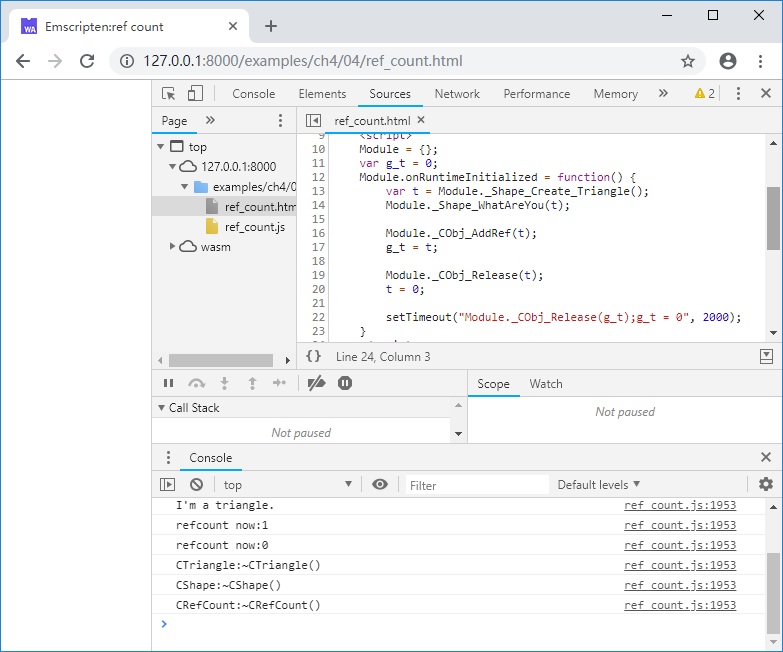4.4 C++对象生命周期控制
C没有GC机制,当C对象被导出到JavaScript环境后,必须使用某种方法进行对象生命周期管理,以彻底杜绝野指针、内存泄漏,引用计数无疑是最常用的方法。
4.4.1 引用计数基类
对象生命周期管理需要解决的问题是:当一个对象可能在多个地方被引用时,如何决定何时将其销毁。引用计数法解决这一问题的途径非常简单:
- 每个对象自带一个初值为0的引用计数;
- 对象的每个使用者,在获得一个对象的引用时,将其引用计数加1;
- 对象的使用者在使用完该对象后,并不直接销毁它,而是将其引用计数减1;当引用计数降为0时,说明已经没有任何使用者持有该对象的引用,可以将其安全的销毁。
C++中一般通过在基类中添加AddRef()和Release()成员函数来实现引用计数的增减,例如:
#include <atomic>
#ifndef SAFE_RELEASE
#define SAFE_RELEASE(p) { if(p) { (p)->Release(); (p)=NULL; } }
#endif
class CRefCount {
public:
CRefCount() : m_ref_count(1) {}
virtual ~CRefCount() {}
void AddRef() {
m_ref_count++;
}
int Release() {
int t = --m_ref_count;
if (t == 0) delete this;
return t;
}
protected:
std::atomic<int> m_ref_count;
};
CRefCount构造时其引用计数成员m_ref_count设为1,因为当我们创建CRefCount的实例时立即获得了该对象的引用(指针),此时引用计数就应为1。计数成员m_ref_count为std::atomic<int>型,该类型可以保证在多线程条件下的原子操作,避免并发读写错误。
4.4.2 AddRef()/Release()使用规则
AddRef()/Release()的使用一般遵循以下规则:
- 当对象的引用从一个内存位置拷贝到另一个内存位置的时候,应该调用
AddRef();当一个内存位置所指向的内存引用不再使用时,应该调用Release()并将该内存位置设为null; - 如果一个内存位置之前保存了一个非空对象A的引用,在向其中写入另一个非空对象B的引用时,应该先调用A对象的
Release(),以通知A对象不再被使用,然后再调用B对象的AddRef(); - 多个内存位置之间的对象引用的关系有特殊约定时,可以省略多余的
AddRef()/Release()。
第1条与第2条相对好理解,比较麻烦的是第3条,例如:
CRefCount* obj = new CRefCount();
obj->AddRef();
//do sth. with obj:
Func(obj);
obj->Release();
SAFE_RELEASE(obj);
围绕Func(obj)上下的AddRef()和Release()事实上是不必要的,因为obj在执行Func(obj)的过程中始终是有效的;再比如:
void Func(CRefCount* obj) {
if (!obj) return;
obj->AddRef();
CRefCount* temp = obj;
//do sth. with temp:
//...
SAFE_RELEASE(temp);
}
obj->AddRef()和temp->Release()也是无必要的,因为局部变量temp的生命周期与Func()函数一致,已被包含在obj的生命周期中。
引用计数增减规则可以简化为:
- 对于传入的对象,如果将其保存到了其他的位置,调用
AddRef(),否则可不调用; - 对于传出的对象,无论是通过返回值传出,还是通过指针参数传出,都要调用
AddRef(); - 对于传入/传出的对象(既使用指针引用参数,在函数内部更改了引用参数的情况),先
Release(),更改后AddRef(); - 不清楚的情况下,一律加上
AddRef()/Release()。
第1~3条分别对应以下例子:
第1条:
void Func(CRefCount* obj) {
//do sth. with obj:
//...
}
第2条:
CRefCount* g_obj = new CRefCount();
CRefCount* GetGlobalObj() {
g_obj->AddRef();
return g_obj;
}
第3条:
CRefCount* g_obj = new CRefCount();
void UpdateObj(CRefCount*& obj) {
SAFE_RELEASE(obj);
g_obj->AddRef();
obj = g_obj;
}
4.4.3 导出AddRef()/Release()
根据4.3节的介绍,如果所有的C++对象都继承自同一个CRefCount基类,那么只需要导出CRefCount的AddRef()/Release()即可,无需单独为每个子类导出引用计数增减函数。例如:
//ref_count.cpp
#include <stdio.h>
#include <atomic>
#ifndef SAFE_RELEASE
#define SAFE_RELEASE(p) { if(p) { (p)->Release(); (p)=NULL; } }
#endif
class CRefCount {
public:
CRefCount() : m_ref_count(1) {}
virtual ~CRefCount() { printf("CRefCount:~CRefCount()\n"); }
void AddRef() {
m_ref_count++;
}
int Release() {
int t = --m_ref_count;
printf("refcount now:%d\n", t);
if (t == 0) delete this;
return t;
}
protected:
std::atomic<int> m_ref_count;
};
struct RefCount;
EM_PORT_API(void) CObj_AddRef(struct RefCount* obj) {
CRefCount *ro = (CRefCount*)obj;
ro->AddRef();
}
EM_PORT_API(int) CObj_Release(struct RefCount* obj) {
CRefCount *ro = (CRefCount*)obj;
if (ro) {
return ro->Release();
}
else return 0;
}
//-----------------------------------
class CShape : public CRefCount{
public:
CShape() {}
virtual ~CShape() { printf("CShape:~CShape()\n"); }
virtual void WhatAreYou() = 0;
};
struct Shape;
EM_PORT_API(void) Shape_WhatAreYou(struct Shape* shape) {
CShape *obj = (CShape*)shape;
obj->WhatAreYou();
}
//-----------------------------------
class CTriangle : public CShape {
public:
CTriangle() {}
virtual ~CTriangle() { printf("CTriangle:~CTriangle()\n"); }
void WhatAreYou(){ printf("I'm a triangle.\n"); }
};
EM_PORT_API(struct Shape*) Shape_Create_Triangle() {
CTriangle *obj = new CTriangle();
return (struct Shape*)obj;
}
JavaScript代码如下:
//ref_count.html
Module = {};
var g_t = 0;
Module.onRuntimeInitialized = function() {
var t = Module._Shape_Create_Triangle();
Module._Shape_WhatAreYou(t);
Module._CObj_AddRef(t);
g_t = t;
Module._CObj_Release(t);
t = 0;
setTimeout("Module._CObj_Release(g_t);g_t = 0", 2000);
}
浏览页面,过2秒后控制台输出如下:
至此,我们完成了C++对象的导出及生命周期控制。
书籍推荐
